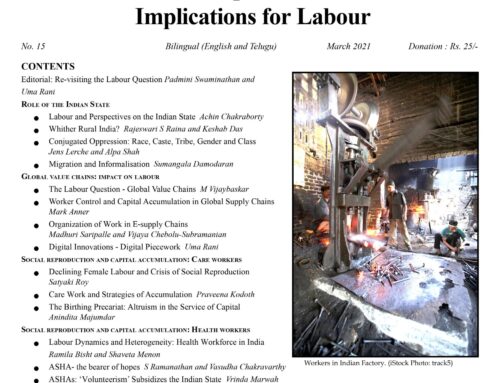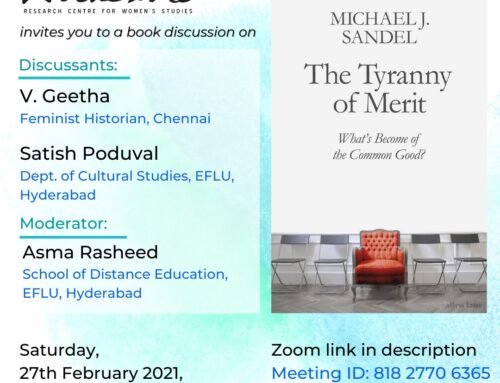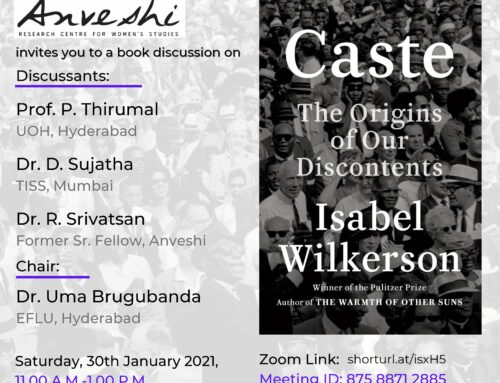filed by senior teachers in a PIL regarding suicides taken by the AP High Court, in April 2013.
We are all teachers who are deeply concerned about these suicides and the crisis in the universities that they point to. Our desire is to help the Court to understand why these suicides have taken place and urge that it takes note of the contexts that seem to be pushing students to take such terminal steps. We believe that the suicides are only the tip of the iceberg of many problems the student community (especially dalits and other marginalized groups) is experiencing. These include: failure and constant fear of failing the examinations; insult; a sense of being stigmatized, unwanted or rejected socially and academically; consequent demoralization and lack of self belief; having failed not knowing how to face families who have struggled to educate them; not being able to fulfill the responsibility of supporting parents and siblings; sexual harassment; not having the economic resources to survive outside the university campuses–just to mention a few examples. University administrations have generally attributed these deaths to personal psychology instead of attempting to seriously study the problem and initiate broad systemic and attitudinal reforms.
1. Analysis of Context
Social profiles of students who died are as follows. Across Hyderabad an overwhelming proportion of student suicides are of those belonging to marginalized social backgrounds. This marginalization may relate to caste, region, language, minority status and sexual orientation. The following examples demonstrate this trend:
- · Pulaya Raju committed suicide in March 2013. Aged 21 years, he was a student of 8th semester of the Integrated MA Linguistics at UoH, belonging to Scheduled Caste. He was from Warangal district and his father was a mine worker. Raju was the first to enter university in his family. After he cleared the courses in six semesters successfully (elsewhere this would have earned him a BA degree, but not in UoH), he got detained in four courses in the seventh semester. At the time of his death, he was uncertain and anxious about his next semester registration.
- · Mudasir Kamran, a Kashmiri student of EFL-U committed suicide in 2013. At the time of his death, he was writing his Ph.D thesis in the Department of English Language Teaching. He was distraught about being taken to the police station over a quarrel with a fellow student.
- · Rajitha, committed suicide in 2011. She was a 1st year student of MA Political Science in Osmania University. She came from a Scheduled Caste agricultural family. Her ambition was to join the Police Department. She could not face harassment from a male classmate.
- · Senthil Kumar died in the year 2008. Senthil Kumar, pursuing Ph.D in Physics at HCU was from a Panniandi (pig-rearing caste) family in Tamil Nadu. His parents were agricultural workers. He was worried about failing in the exams, finding a supervisor at the end of first year and about his scholarship (part of which he sent home regularly) being discontinued.
- · Malleshwari aged 21 years committed suicide in the year 2007. She was studying B.Tech in the College of Technology, Osmania Unviersity. She was from a poor backward caste family in Nellore district of Andhra Pradesh. After getting detained in her first and second semesters with 50% backlogs, she committed suicide.
While it is impossible to establish a single “explanation” for any of these suicides, each of them have raised a number of structural problems that relate to the crisis that the universities are facing today.
Failure has a specific meaning for these students. Due to many reasons, ‘discontinuing’ and going back home is not a viable option for poor, rural students, who may chose death over a future in which they must stare at their inability to provide for miserably poor families that have staked everything to educate them. In many cases they were also the academic “toppers” in a village or a community and the ignominy of returning as failures would also be unbearable.
There has been a demographic shift in the student population of the universities. From 1990s onwards, the number of students from marginalized groups reaching universities has steadily increased. Expansion in the scope of reservation to include backward castes has succeeded in bringing new groups into the universities. Increased vigilance has ensured that the SC-ST quotas are better filled. As such, this increase in the diversity of students is surely a welcome change and of signal importance in national life.
The suicides, we believe, point to the exclusionary mindset operative within the universities. This is usually also endorsed in the articulation of student anger following such events. While the acts and attitudes that emerge from this mindset may not always be willful or conscious, the mindset surfaces consistently in entrance procedures and norms, administrative arrangements, rules, curricula, teaching practices, testing and examination practices, various institutional procedures, faculty-student relations, indeed the entire culture of the university and its everyday life. We feel that the university and we, as members of it, have not taken the challenge of addressing and dismantling this mindset seriously enough. In other words, the multidimensional intellectual and institutional effort that is essential if this mindset is to be changed so that new students made part of the larger community has not been actively fostered. This may be done through institutional mandate (as for example in the noting of failure or dropout rates; focus on curricular change designed to “leave no student behind”; profiling of faculty and departments with a history of failed students) or through broad-based cultural initiatives. On the contrary student anguish or anger has all too often been taken as depression or rowdyism and medicalized or criminalized.
All these problems raise many administrative challenges in terms of faculty-student ratio, hostel facilities, admissions, examinations, adequate number of administrative staff etc. which nevertheless do not receive adequate attention. Across the universities students report facing innumerable problems related to crowding, inadequacy and poor hygiene of toilets and other hostel facilities, shortage of food and drinking water (queues may be so long that students have to leave for class without lunch/breakfast). Lack of facilities and arrangements (more so for girls) for games and recreation is another factor impeding a healthy social life.
Students from marginalized groups also are troubled by lack of clarity and sometimes contradictions in examination and administrative procedures (a faculty member may not have declared the results of his/her course, but a registration cut-off date is enforced), rules that do not take into account their difficulties, and discretionary and biased treatment from the administration. For example, ‘don’t waste my time’, ‘go away’, ‘come tomorrow’, ‘I am busy now’, ‘your presence irritates me’ (the last spoken by a deputy registrar sitting in an air conditioned room) have become routine! They feel unwelcome –and experience a lack of mooring, support, and abandonment. In spite of the goodwill shown by a few individual faculty members, they experience the university to be ‘hostile’ towards them.
Universities, in our opinion, are also yet to acknowledge the need to change the prevailing academic culture of the university. We have been slow to engage with and adapt to new student needs, let alone challenge already established knowledge structures. The extraordinary merit of these students reaching the portals of the university despite all adversity is unrecognized and we continue to see them as a backward burden on the university system. We need to ask ourselves why far too many of the students who have made their way into the “big” universities through reservations and supported by national fellowships, drop out. Why are they, as a group, failing? Why do they begin, often for the first time in their lives to do badly in class, feel unwanted and unfairly treated, harassed by norms and regulations? A simple example of unfriendly regulations is the UoH system of registering every semester, which poses a lot of problems to these students who have to obtain ‘no dues’ certificates from six different people, including the library. Anyone who delays this procedure by a few days has to pay a penalty for identity cards and other administrative essentials. The lack of coordination between the Centre for Integrated Studies which runs the IMA programme, Departments at the post-graduate level, and examination branches is resulting in confusion regarding backlog/supplementary exams and eligibility of students for appearing in the next semester exams.
2. Agenda for Change
It is submitted that serious curricular changes need to be made to ensure that the students from these groups will successfully complete their courses and acquire the required skills (for jobs). We continue to teach subjects, without thoughtfully rethinking and reorganizing the material and for the actual students in the classroom.Students are left feeling that the courses are designed to show up their inadequacy, not to help them learn. Curricula and pedagogy remains oriented to students from elite backgrounds.
The flexibility and openness to innovation of the semester system offers some avenues for adapting courses to suit new populations of students entering the university. This has not been fully exploited. Substantial work has to go into designing new curricula taking into account students’ strength, addressing their interests and gaps in abilities, and mediating between them and the possibilities of employment. There has been some acknowledgement of the necessary structural changes such as the establishment of Centres for Women’s Studies, Social Exclusion and Inclusive Policy and introduction of a few courses in Gender/Dalit studies; but their contribution is isolated and academic. These issues do not become a serious concern of the university as a whole.
The Public Culture of the University needs to be actively changed. This can be done through rules, procedures of accountability, academic discussions, and, not least, cultural initiatives. The administration should visibly demonstrate that it is taking seriously its responsibility to what is, after all, the majority of people in this country. While these problems may be somewhat difficult, they are not insurmountable. Similar problems have been institutionally addressed with success in other countries, and adaptation is possible. For example, administrative fairness and justice for marginalized populations is a well-known fact about educational institutions in the US.
The University should be a location that facilitates the shaping of egalitarian and universal knowledge, the interaction of castes, classes, religions, regions and genders, the building of friendships and the development of mutual respect. This is not happening. The loss is economic – that of the investment of a desperately poor family, sometimes and extended family and maybe an entire village; also that of the tax payer and the country. The loss to national culture is inestimable: failure of a critical forerunner sends a bad message to many children looking up to those who have gone ahead of them. Universities in general, and we teachers in particular, need to be more accountable to the high failure rate, anxiety, disturbance that students are experiencing.
It is a matter of very deep concern that all too often police are called into the university. Individual students involved in a quarrel and protesting students (who all too often are calling attention to these structural problems) are being taken to the police (and cases filed against them) for small issues that should have been addressed within the university or problems that have such deep structural roots. The University should by now be aware that problems that are complex and structural cannot be addressed as ones of law and order. Students are threatened and humiliated by this and the results can be tragic. The most recent example is the suicide of Mudassir Kamran at English and Foreign Languages University.
Grievance Redressal Mechanims such as disciplinary committees, grievance cells at the department and university level, sexual harassment committees, SC/ST grievance cells etc. are neither fully functional nor accessible to the students. We would suggest that the revival of these several committees, rather than establishing one general grievance cell, will enable the culture of hearings and redressal to grow. Some universities have some of them in place. In some universities such as Osmania University, a Sexual Harassment Committee is yet to be established. In another example, in the aftermath of the suicide of Senthil Kumar, PhD student, in 2008, a Fact Finding Committee was constituted by the University of Hyderabad. One of the important findings of this Report was the need for Grievance Redressal mechanisms for every School/Department in the University where students can go with their problems. The Report also emphasizes the need to nurture and take care of those students who come from marginalized backgrounds especially in a context where the watch words for contemporary university are that of access and equity. Reviving and strengthening the operation of these committees would go a long way towards establishing administrative fairness.
Towards this objective – of redefining the public culture of the universities, we have to radically rethink indicators of the formal educational system such as failure, drop out, forced discontinuation, irrational decline in the performance of entry level students (e.g. school or district toppers doing badly in university), even student anger against rules and procedures. The rethinking is all the more necessary as these indicators continue to be interpreted as student failure, and not as institutional inadequacy.
Provision needs to be made for an adequate number of counselors who are also aware of and trained to respond to the kinds of tensions and pressures individual students may be experiencing. Women or dalit and other marginalized students facing harassment or demoralization, minority students ever in danger of being labeled as terrorist or scoffed at for wearing the hijab, those wrestling with issues of their sexuality and/or sexual orientation, also need help to confront these issues. Though many of these problems are structural, it is individuals who suffer their effects. They need help to recognize the problems and deal with them productively and not destroy themselves through shame or self blame.
We have taken this opportunity of submitting a set of recommendations drawn from our experiences to make University education more inclusive and accessible. Such an exercise requires a wide range of issues to be addressed which include new set of curricula, administrative systems, teaching methods, policy initiatives, and general cultural orientation keeping in mind the fact that the university is one of the most important transformative institutions in India today.
Our plea is that an Inquiry Committee be constituted to study the whole wide range of issues that bear on student suicides. The Committee may also hold well publicized Open Hearings in the different universities, and receive written submissions from the public. We the undersigned teachers are willing to assist this Court in laying down substantial ground rules for revisualising / revitalizing the university system as it exists today.
Signatories
Prof. G Haragopal, Rt Professor from Department of Political Science, HCU
Prof. Rama Melkote, Retd Professor, Department of Political Science, OU
Prof. Jacob Tharu, Retd Professor of Educational Evaluation, EFL-U
Prof. D.Narasimha Reddy, Sankaran Chair, NIRD, Hyderabad
Dr. K. Satyanarayana, Associate Professor, Department of Cultural Studies, EFL-U
Prof. M.T.Ansari, Director, Centre for Comparative Literature, HCU
Dr. Bhangya Bhukya, Associate Professor, Dept of Social Exclusion Studies, EFL -U
Prof. Susie Tharu, Department of Cultural Studies, EFL-U
Prof. Padmini Swaminathan, Centre for Livelihoods Research, TISS, Hyderabad
Prof. PL Vishweshwar Rao, Head, Department of Journalism, MANUU
Prof. Mariappan Periasamy, School of Chemistry, University of Hyderabad
Dr R Akhileshwari, Associate Professor, Dept of Journalism, OU
Dr. P Madhavi, Retired Associate Professor in Commerce, OU
Prof. T Nageswara Rao, Department of Commonwealth Literary Studies, EFL-U
Prof. D Vasanta, Department of Linguistics, OU
Prof. U Vindhya, Chairman, Academic Programmes, TISS, Hyderabad
Prof. P.Muthaiah, Department of Political Science, OU
Prof. Madhava Prasad, Department of Cultural Studies, EFL-U
Prof. Madabhushi Sridhar, NALSAR University of Law, Hyderabad
Prof. K.Srinivasulu, Department of Political Science, OU
Prof. Sasheej Hegde, Department of Sociology, HCU
Dr. K.Lakshminarayana, Associate Professor, Dept. of Economics, HCU
Prof. Vinod Pavarala, Sarojini Naidu School of Arts and Communication, HCU
Prof. Gaddam Krishna Reddy, Department of Political Science, OU
Dr. P Thirumal, Associate Professor, SN School, HCU
Prof. R.V Ramana Murthy, Department of Economics, HCU
Dr.S. Durga Bhavani, Associate Professor, School of Computer and Information Sciences, HCU
Dr. Rekha Pappu, Associate Professor, Centre for Education, TISS, Hyderabad





The issues raised in the petition deserve our serious attention and to my mind, some of the changes brought in by University of Delhi in its Four Year Undergraduate Programme address some of the problems.
For instance, instead of continuing with the earlier practice where each student works for himself/herself, often in competition with all others in the class, students now have to compulsorily work in groups of five for their project and presentations. Teachers assume roles of mentors to encourage teamwork, sharing, peer learning, taking initiative, etc. In many cases, class fellows who would have otherwise not been friends, have been brought together to their mutual benefit. Since they now have to do projects that need to have some component of “practical work’ related to contemporary social issues, there is some meaningful interaction among students and other sections of society.
Another laudable innovation has been to allocate more than 70% of marks in Foundation Courses and 100% in Application Courses to Internal Assessment. This will certainly reduce stress that end-of-semester written examination causes. Teachers are however apprehensive of how effective “teaching-learning” will be under these changed circumstances and have expressed serious concerns of “dilution”, etc. It is difficult to balance the needs, aspirations and expectations of different groups within the university community.